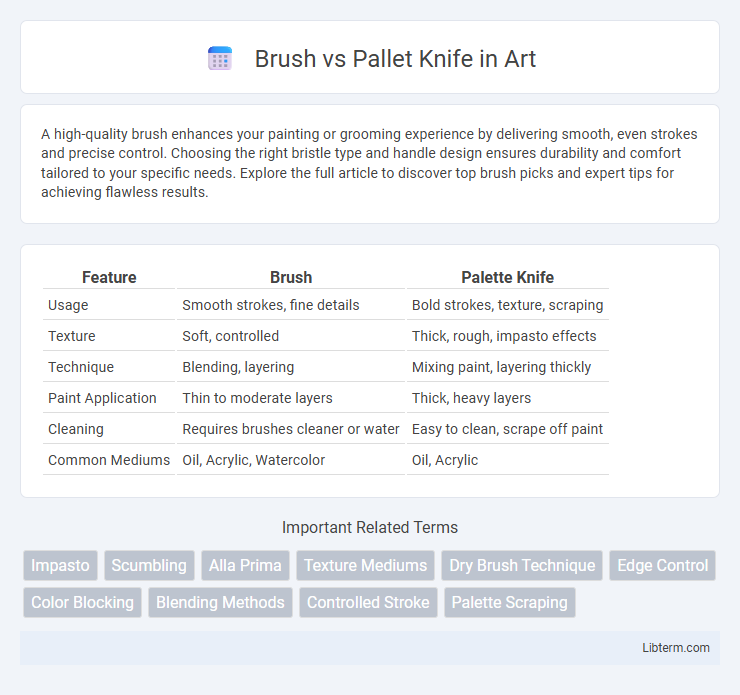A high-quality brush enhances your painting or grooming experience by delivering smooth, even strokes and precise control. Choosing the right bristle type and handle design ensures durability and comfort tailored to your specific needs. Explore the full article to discover top brush picks and expert tips for achieving flawless results.
Table of Comparison
| Feature | Brush | Palette Knife |
|---|---|---|
| Usage | Smooth strokes, fine details | Bold strokes, texture, scraping |
| Texture | Soft, controlled | Thick, rough, impasto effects |
| Technique | Blending, layering | Mixing paint, layering thickly |
| Paint Application | Thin to moderate layers | Thick, heavy layers |
| Cleaning | Requires brushes cleaner or water | Easy to clean, scrape off paint |
| Common Mediums | Oil, Acrylic, Watercolor | Oil, Acrylic |
Introduction: Understanding Brushes and Palette Knives
Brushes, crafted from natural or synthetic bristles, offer precise control and versatility for detailed painting, blending, and fine textures. Palette knives, typically made of flexible steel blades, excel in applying thick, textured layers of paint and creating bold, impasto effects. Understanding the unique functions of brushes and palette knives enhances artistic technique and broadens creative expression.
Historical Background of Painting Tools
Painting tools such as brushes and palette knives have distinct historical backgrounds that shaped artistic techniques throughout centuries. Brushes, with origins tracing back to ancient civilizations like Egypt and China, evolved from natural bristles bound to handles, enabling detailed and precise brushwork essential in classical and Renaissance art. Palette knives emerged later, gaining prominence during the 19th century Impressionist movement, valued for their ability to create textured, expressive strokes and apply thick layers of paint, revolutionizing modern painting styles.
Key Differences Between Brushes and Palette Knives
Brushes offer precise control and smooth application ideal for detailed work and fine lines, while palette knives create textured, bold strokes suited for impasto techniques and mixing paint directly on canvas. Brushes vary in shape, size, and bristle type, affecting paint flow and finish, whereas palette knives feature flexible, blunt edges designed for spreading and layering thick paint. The choice between brush and palette knife influences the artwork's style, texture, and depth, making each tool essential for different painting techniques.
Advantages of Using Brushes
Brushes offer superior versatility and control for detailed painting, allowing artists to create smooth gradients, fine lines, and intricate textures with various bristle types tailored for specific techniques. Their ability to hold and evenly distribute paint ensures consistent coverage and precise application on diverse surfaces. Compared to palette knives, brushes enable refined blending and layering, making them essential tools for realistic and expressive artworks.
Advantages of Using Palette Knives
Palette knives offer superior control for mixing and applying thick layers of paint, creating textured effects that brushes cannot achieve. Their flexible, non-absorbent blades prevent paint waste and enable easy cleanup, enhancing efficiency in both oil and acrylic painting. Artists appreciate palette knives for their ability to produce sharp edges and distinct strokes, making them ideal for expressive, impasto techniques.
Texture and Finish: Brush vs Palette Knife Effects
Brush strokes create smooth, controlled textures ideal for detailed work and subtle gradations, producing a polished finish with visible bristle marks enhancing depth. Palette knives generate bold, impasto textures through thick, layered paint application, resulting in a raised, tactile surface with a more abstract and expressive finish. Artists often combine both tools to balance precision and texture, achieving dynamic visual contrasts in their paintings.
Ideal Paint Types for Each Tool
Brushes are ideal for water-based paints like acrylics and latex due to their ability to create smooth, even coats and fine details. Pallet knives excel with oil paints and heavy-bodied acrylics, enabling thick, textured applications and impasto techniques. Selecting the appropriate tool enhances paint handling and final artwork texture.
Popular Techniques with Brushes and Palette Knives
Popular techniques with brushes include blending, glazing, and stippling, which enable smooth transitions, layered textures, and intricate detailing in paintings. Palette knives excel in impasto technique, creating thick, textured applications of paint that add dimension and bold strokes to artwork. Combining brush and palette knife methods enhances visual depth and variety, allowing artists to achieve both fine detail and expressive, tactile effects.
Choosing the Right Tool for Your Artistic Style
Choosing the right tool for your artistic style depends on the desired texture and detail in your artwork. Brushes offer precision and smooth blending, ideal for fine details and realistic effects, while palette knives create bold, textured strokes with dynamic impasto techniques often favored in abstract and expressive paintings. Consider the medium, surface, and intended visual impact to determine whether a brush or palette knife will best enhance your creative expression.
Conclusion: Brush or Palette Knife—Which Suits You Best?
Choosing between a brush and a palette knife depends on your desired painting style and texture preferences. Brushes offer precision and smooth blending ideal for detailed work, while palette knives create bold, textured strokes perfect for expressive, impasto techniques. Assess your artistic goals and experiment with both tools to determine which enhances your creative expression most effectively.
Brush Infographic

 libterm.com
libterm.com